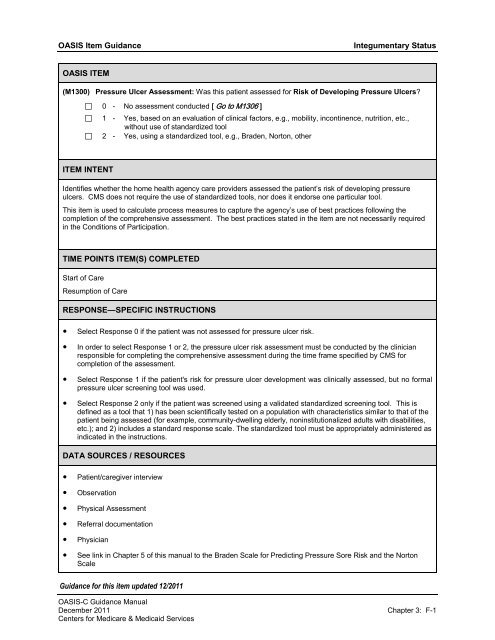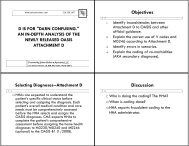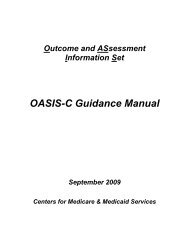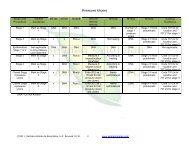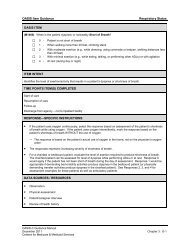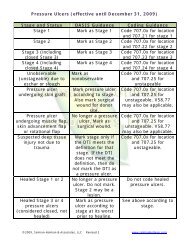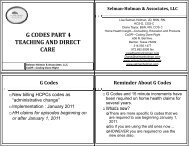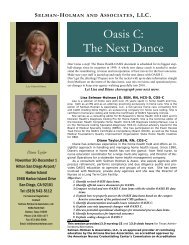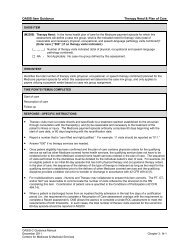F Integumentary Status - Selman-Holman & Associates
F Integumentary Status - Selman-Holman & Associates
F Integumentary Status - Selman-Holman & Associates
You also want an ePaper? Increase the reach of your titles
YUMPU automatically turns print PDFs into web optimized ePapers that Google loves.
OASIS Item Guidance<strong>Integumentary</strong> <strong>Status</strong>RESPONSE—SPECIFIC INSTRUCTIONS (cont’d for OASIS Item M1308)●●●●●●A muscle flap, skin advancement flap, or rotational flap (defined as full thickness skin and subcutaneoustissue partially attached to the body by a narrow strip of tissue so that it retains its blood supply) performed tosurgically replace a pressure ulcer is a surgical wound. It should not be reported as a pressure ulcer onM1308.A pressure ulcer treated with a skin graft (defined as transplantation of skin to another site) remains apressure ulcer and should not be reported as a surgical wound on M1342. Until the graft edges completelyheal, the grafted pressure ulcer should be reported on M1308 as d.1 (unstageable) pressure ulcer. Thenumber of pressure ulcers meeting these definitions should be counted to determine the response to d.1.Once the graft edges heal, the closed Stage III or Stage IV pressure ulcer would continue to be regarded as apressure ulcer at its worst stage.A pressure ulcer that has been surgically debrided, remains a pressure ulcer and should not be reported as asurgical wound on M1342.Pressure ulcers that are known to be present or that the care provider suspects may be present based onclinical assessment findings (e.g., patient report of discomfort, past history of skin breakdown in the samearea), but that are unstageable due to dressings or devices (e.g., casts) that cannot be removed to assess theskin underneath should be reported as d.1 (unstageable).Response d.2 refers to pressure ulcers that the care provider suspects may be present based on clinicalassessment findings (e.g., patient report of discomfort, past history of skin breakdown in the same area), butcannot be staged due to full thickness tissue loss in which the true wound depth is obscured by slough(yellow, tan, gray, green or brown) and/or eschar (tan, brown or black) in the wound bed. The number ofpressure ulcers meeting this definition should be counted to determine the response to d.2.Response d.3 refers to a suspected deep tissue injury in evolution, which is defined by the NPUAP as apurple or maroon localized area of discolored intact skin or blood-filled blister due to damage of underlyingsoft tissue from pressure and/or shear. The area may be preceded by tissue that is painful, firm, mushy,boggy, warmer, or cooler as compared to adjacent tissue. The number of pressure ulcers meeting thisdefinition should be counted to determine the response to d.3. Deep tissue injury may be difficult to detect inindividuals with dark skin tones. Evolution may include a thin blister over a dark wound bed. The wound mayfurther evolve and become covered by thin eschar. Evolution may be rapid, exposing additional layers oftissue even with optimal treatment.DATA SOURCES / RESOURCES●●●●●●●●Patient/caregiver interviewObservationPhysical AssessmentClinical recordReferral documentationPhysicianConsult published guidelines of NPUAP for additional clarification and/or resources for training. Resourcesand links can be found in Chapter 5 of this manual.See Chapter 5 of this manual for NPUAP staging illustrations.Guidance for this item updated 12/2011OASIS-C Guidance ManualDecember 2011 Chapter 3: F-8Centers for Medicare & Medicaid Services
OASIS Item Guidance<strong>Integumentary</strong> <strong>Status</strong>OASIS ITEMDirections for M1310, M1312, and M1314: If the patient has one or more unhealed (non-epithelialized) Stage IIIor IV pressure ulcers, identify the Stage III or IV pressure ulcer with the largest surface dimension (length xwidth) and record in centimeters. If no Stage III or Stage IV pressure ulcers, go to M1320.(M1310) Pressure Ulcer Length: Longest length “head-to-toe” | ___ | ___ | . | ___ | (cm)(M1312) Pressure Ulcer Width: Width of the same pressure ulcer; greatest width perpendicular to the length| ___ | ___ | . | ___ | (cm)(M1314) Pressure Ulcer Depth: Depth of the same pressure ulcer; from visible surface to the deepest area| ___ | ___ | . | ___ | (cm)ITEM INTENTIdentifies the length, width, and depth of the pressure ulcer with the largest surface area (length x width) that isalso an unhealed Stage III or IV pressure ulcer or pressure ulcer unstageable due to the presence of slough oreschar (as reported in M1308 d.2).TIME POINTS ITEM(S) COMPLETEDStart of careResumption of careDischarge from agency – not to inpatient facilityRESPONSE—SPECIFIC INSTRUCTIONS●●●●●●Complete these items only if M1308 Column 1, rows b, c, or d.2 is greater than 0. Otherwise, leave theseitems blank.Identify the pressure ulcer reported in M1308, Column 1, rows b, c, or d.2, with the largest surface dimension(length x width) and record in centimeters.If all existing Stage III or IV pressure ulcers are closed (completely re-epithelialized) and the patient has nopressure ulcers that are unstageable due to coverage of the wound bed by slough and/or eschar, enter 00.0for M1310, M1312, and M1314.Measure every existing non-epithelialized stage III or IV pressure ulcer or pressure ulcer that is unstageabledue to the presence of slough or eschar (as reported in M1308 d.2) to determine which has the largest surfacedimension (length x width). Depth should not be considered in determining which pressure ulcer is largest.Once the largest pressure ulcer has been determined, report length (M1310), width (M1312), and depth(M1314) dimensions for that pressure ulcer. Depth for a wound covered/filled with eschar can be entered as00.0.- Report the depth from the visible surface to the deepest area in the base of the wound. Do not includethe depth of any tunneling present.Measurement should be based on observation of the pressure ulcer after the dressing and any exudate areremoved.OASIS-C Guidance ManualDecember 2011 Chapter 3: F-9Centers for Medicare & Medicaid Services
OASIS Item Guidance<strong>Integumentary</strong> <strong>Status</strong>RESPONSE—SPECIFIC INSTRUCTIONS (cont’d for OASIS Items M1310, M1312, and M1314)●●To measure pressure ulcers, use a disposable measuring device, a cotton-tipped applicator, a camera, orother wound technology that calculates measurements. If using a cotton-tipped applicator, mark on theapplicator the distance between healthy skin tissue at each margin and lay the applicator next to a centimeterruler to determine length, width, and depth. Round the measurement to the nearest tenth of a centimeter.Any wound or pressure ulcer that you are able to visualize even if all you see is a wound bed that is 100%covered with slough/eschar needs to be measured.Determine longest length head to toe (white line) and longest width (black line) of each pressure ulcer (seepicture below). Width is measured at the widest width perpendicular (i.e., at a 90 degree angle) to the lengthforming a cross, side to side).- Pressure ulcers that lie diagonally or slanted are also measured head to toe for length and the widthmeasurement is perpendicular to the length. You may choose to include other measurements in yourclinical documentation, for situations where the OASIS requirement does not meet your needs.(picture attached)DATA SOURCES / RESOURCES●●ObservationPhysical assessmentOASIS-C Guidance ManualDecember 2011 Chapter 3: F-10Centers for Medicare & Medicaid Services
OASIS Item Guidance<strong>Integumentary</strong> <strong>Status</strong>OASIS ITEM(M1320) <strong>Status</strong> of Most Problematic (Observable) Pressure Ulcer:⃞ 0 - Newly epithelialized⃞ 1 - Fully granulating⃞ 2 - Early/partial granulation⃞ 3 - Not healing⃞ NA - No observable pressure ulcerITEM INTENTIdentifies the degree of closure visible in the most problematic observable pressure ulcer, stage II or higher.Please note, Stage I pressure ulcers are not considered for this item.TIME POINTS ITEM(S) COMPLETEDStart of careResumption of careDischarge from agency – not to inpatient facilityRESPONSE—SPECIFIC INSTRUCTIONS●●●●●●●●●●●Determine the most problematic pressure ulcer. Visualization of the wound is necessary to identify the degreeof healing evident in the ulcer identified in M1320.“Most problematic” may be the largest, the most advanced stage, the most difficult to access for treatment, themost difficult to relieve pressure, etc., depending on the specific situation.If the patient has only one observable pressure ulcer, then that ulcer is the most problematic.Mark the response that most accurately describes the healing process you see occurring in the mostproblematic pressure ulcer.Stage III and IV pressure ulcers close by contraction, granulation, and epithelialization. Epithelialization isregeneration of the epidermis across a wound surface.Mark response 0 – Newly epithelialized – when epithelial tissue has completely covered the wound surface ofthe pressure ulcer, regardless of how long the pressure ulcer has been re-epithelialized. This is anappropriate response for Stage III and IV pressure ulcers, but not for Stage II ulcers as fully epithelializedStage II ulcers should not be reported.Response 1 – Fully Granulating – is the appropriate response for a Stage III or IV pressure ulcer that is fullygranulated, but epithelial tissue has not completely covered the wound surface.Because Stage II ulcers do not granulate and newly epithelialized Stage II ulcers are not counted, the onlyappropriate response for Stage II ulcers is 3 – Not healing.Since suspected deep tissue injury (DTI) does not granulate and would not be covered with new epithelialtissue, the status of “Not healing” is the most appropriate response.”No observable pressure ulcer” includes only those that cannot be observed due to the presence of a dressingor device that cannot be removed (including casts). (When determining the healing status of a pressure ulcerfor answering M1320, the presence of necrotic tissue does NOT make the pressure ulcer NA – No observablepressure ulcer.)A pressure ulcer with necrotic tissue (eschar/slough) obscuring the wound base cannot be staged, but itshealing status is either Response 2 – Early/partial granulation if necrotic or avascular tissue covers
OASIS Item Guidance<strong>Integumentary</strong> <strong>Status</strong>DATA SOURCES / RESOURCES (cont’d for OASIS Item M1320)●Observation●Review of health history●Physical Assessment●Physician●Referral documentation●Additional resources for the WOCN, the NPUAP, andthe NQF can be found in Chapter 5 of this manual.OASIS-C Guidance ManualDecember 2011 Chapter 3: F-12Centers for Medicare & Medicaid Services
OASIS Item Guidance<strong>Integumentary</strong> <strong>Status</strong>OASIS ITEM(M1322) Current Number of Stage I Pressure Ulcers: Intact skin with non-blanchable redness of a localizedarea usually over a bony prominence. The area may be painful, firm, soft, warmer, or cooler ascompared to adjacent tissue.⃞ 0 ⃞ 1 ⃞ 2 ⃞ 3 ⃞ 4 or moreITEM INTENTIdentifies the presence of Stage I pressure ulcers.TIME POINTS ITEM(S) COMPLETEDStart of careResumption of careFollow-upDischarge from agency – not to inpatient facilityRESPONSE—SPECIFIC INSTRUCTIONS●●NPUAP defines a stage I ulcer as follows: “Intact skin with non-blanchable redness of a localized area usuallyover a bony prominence. Darkly pigmented skin may not have visible blanching; its color may differ from thesurrounding area.”Further description: “The area may be painful, firm, soft, warmer, or cooler as compared to adjacent tissue.Stage I may be difficult to detect in individuals with dark skin tones. May indicate "at risk" persons (a heraldingsign of risk).”DATA SOURCES / RESOURCES●●●●Patient/caregiver interviewObservationPhysical AssessmentSee Chapter 5 of this manual for more information regarding NPUAP staging illustrations.OASIS-C Guidance ManualDecember 2011 Chapter 3: F-13Centers for Medicare & Medicaid Services
OASIS Item Guidance<strong>Integumentary</strong> <strong>Status</strong>OASIS ITEM(M1324) Stage of Most Problematic Unhealed (Observable) Pressure Ulcer:⃞ 1 - Stage I⃞ 2 - Stage II⃞ 3 - Stage III⃞ 4 - Stage IV⃞ NA - No observable pressure ulcer or unhealed pressure ulcerITEM INTENTIdentifies the stage of the most problematic observable Stage 1 or higher pressure ulcer. Definitions of pressureulcer stages derived from the National Pressure Ulcer Advisory Panel.TIME POINTS ITEM(S) COMPLETEDStart of CareResumption of CareFollow-upDischarge from agency - not to an inpatient facilityRESPONSE—SPECIFIC INSTRUCTIONS●●●●●●●●Determine the most problematic pressure ulcer. Visualization of the wound base is necessary to identify thedegree of healing evident in the ulcer.“Most problematic” may be the largest, the most advanced stage, the most difficult to access for treatment, themost difficult to relieve pressure, etc., depending on the specific situation.Mark the response that most accurately describes the stage of the most problematic pressure ulcer.If the patient has only one observable pressure ulcer, then that ulcer is the most problematic.Use the NPUAP definitions to determine the stage of the most problematic pressure ulcer.Until suspected deep tissue injury (DTI) evolves and opens, the stage will be considered “NA,” as the woundbed cannot be visualized.Select “NA” if the patient has NO pressure ulcers or has pressure ulcers that cannot be observed due to thepresence of necrotic tissue (including eschar or slough) that obscures visualization of the wound base, or adressing or device that cannot be removed (e.g., a cast).Reverse staging of granulating pressure ulcers is NOT an appropriate clinical practice according to theNational Pressure Ulcer Advisory Panel (NPUAP). If a pressure ulcer is Stage III at SOC and is granulating atthe follow-up visit, the ulcer remains a Stage III ulcer. A healed Stage III or Stage IV pressure ulcer continuesto be regarded as a pressure ulcer at its worst stage. However, an unhealed active ulcer at a lower stage maybe the most problematic ulcer. A previously healed Stage III or Stage IV pressure ulcer that breaks downagain should be staged at its worst stage.DATA SOURCES / RESOURCES●Patient/caregiver interview●Review of health history●Observation●Physician●●Physical assessmentReferral documentation●See Chapter 5 of this manual for links to published guidelinesof NPUAP, NPUAP staging illustrations, and WOCNguidelines.OASIS-C Guidance ManualDecember 2011 Chapter 3: F-14Centers for Medicare & Medicaid Services
OASIS Item Guidance<strong>Integumentary</strong> <strong>Status</strong>OASIS ITEM(M1330) Does this patient have a Stasis Ulcer?⃞ 0 - No [ Go to M1340 ]⃞ 1 - Yes, patient has BOTH observable and unobservable stasis ulcers⃞ 2 - Yes, patient has observable stasis ulcers ONLY⃞ 3 - Yes, patient has unobservable stasis ulcers ONLY (known but not observable due to nonremovabledressing) [ Go to M1340 ]ITEM INTENTIdentifies patients with ulcers caused by inadequate venous circulation in the area affected (usually lower legs).This lesion is often associated with stasis dermatitis.Stasis ulcers DO NOT include arterial lesions or arterial ulcers. If the home health clinician conducting theassessment is not sure the wound fits the definition of a stasis ulcer, the clinician should contact the physician forclarification.TIME POINTS ITEM(S) COMPLETEDStart of careResumption of careFollow-upDischarge from agency – not to inpatient facilityRESPONSE—SPECIFIC INSTRUCTIONS●●●●●A response of “Yes” identifies the presence of an ulcer caused by inadequate venous circulation in the areaaffected (usually lower legs).It is important to differentiate stasis ulcers from other types of skin lesions, and only report stasis ulcers in thisitem.Once a stasis ulcer has completely epithelialized, it is considered healed and should not be reported as acurrent stasis ulcer.Select Response 1 if the patient has both an observable stasis ulcer AND a reported stasis ulcer that cannotbe observed because of a cast or dressing (e.g., Unna boot) that cannot be removed. Information may beobtained from the physician or patient/caregiver regarding the presence of a stasis ulcer underneath the castor dressing.Select Response 3 ONLY if the patient has a reported stasis ulcer that cannot be observed because of a castor dressing (e.g., Unna boot) that cannot be removed, and has no observable stasis ulcers. Information maybe obtained from the physician or patient/caregiver regarding the presence of a stasis ulcer underneath thecast or dressing.DATA SOURCES / RESOURCES●Patient/caregiver interview●Observation●Physician●Physical assessment●●●Physician’s ordersReferral informationReview of health history●A link to the Clinical Fact Sheet – Quick Assessmentof Leg Ulcers can be found in Chapter 5 of thismanual.Guidance for this item updated 12/2011OASIS-C Guidance ManualDecember 2011 Chapter 3: F-15Centers for Medicare & Medicaid Services
OASIS Item Guidance<strong>Integumentary</strong> <strong>Status</strong>OASIS ITEM(M1332) Current Number of (Observable) Stasis Ulcer(s):⃞ 1 - One⃞ 2 - Two⃞ 3 - Three⃞ 4 - Four or moreITEM INTENTIdentifies the number of visible (observable) stasis ulcers.TIME POINTS ITEM(S) COMPLETEDStart of careResumption of careFollow-upDischarge from agency – not to inpatient facilityRESPONSE—SPECIFIC INSTRUCTIONS●All stasis ulcers except those that are covered by a nonremovable dressing or cast are consideredobservable.DATA SOURCES / RESOURCES●●●●●ObservationPhysical AssessmentReview of health historyPhysicianReferral informationOASIS-C Guidance ManualDecember 2011 Chapter 3: F-16Centers for Medicare & Medicaid Services
OASIS Item Guidance<strong>Integumentary</strong> <strong>Status</strong>OASIS ITEM(M1334) <strong>Status</strong> of Most Problematic (Observable) Stasis Ulcer:⃞⃞⃞⃞0 - Newly epithelialized1 - Fully granulating2 - Early/partial granulation3 - Not healingITEM INTENTIdentifies the degree of healing present in the most problematic, observable stasis ulcer. The “most problematic”ulcer may be the largest, the most resistant to treatment, an ulcer that is infected, etc., depending on the specificsituation.TIME POINTS ITEM(S) COMPLETEDStart of careResumption of careFollow-upDischarge from agency – not to inpatient facilityRESPONSE—SPECIFIC INSTRUCTIONS●●If the patient has only one stasis ulcer, that ulcer is the most problematic.Once a stasis ulcer has completely epithelialized, it is considered healed and should not be reported as acurrent stasis ulcer. The response option “Newly epithelialized” should not be selected for a healed stasisulcer, as a completely epithelialized (healed) stasis ulcer is not reported as a stasis ulcer on OASIS.DATA SOURCES / RESOURCES●●●●ObservationPhysical AssessmentReview of health historyTo determine healing status of the stasis ulcer, further resource links can be found in Chapter 5 of thismanual.Guidance for this item updated 12/2011OASIS-C Guidance ManualDecember 2011 Chapter 3: F-17Centers for Medicare & Medicaid Services
OASIS Item Guidance<strong>Integumentary</strong> <strong>Status</strong>OASIS ITEM(M1340) Does this patient have a Surgical Wound?⃞ 0 - No [ Go to M1350 ]⃞ 1 - Yes, patient has at least one (observable) surgical wound⃞ 2 - Surgical wound known but not observable due to non-removable dressing [ Go to M1350 ]ITEM INTENTIdentifies the presence of any wound resulting from a surgical procedure.TIME POINTS ITEM(S) COMPLETEDStart of careResumption of careFollow-upDischarge from agency – not to inpatient facilityRESPONSE—SPECIFIC INSTRUCTIONS●●●●●●●●●Old surgical wounds that have resulted in scar or keloid formation are not considered current surgical woundsand should not be included in this item.If the patient has both an observable and an unobservable wound, the best response is 1 – Yes, patient has atleast one (observable) surgical wound).Select Response 2 if a wound is not observable. A wound is considered not observable if it is covered by adressing (or cast) which is not to be removed per physician order.For the purpose of this OASIS item, a surgical site closed primarily (with sutures, staples or a chemicalbonding agent) is generally described in documentation as a surgical wound until re-epithelialization has beenpresent for approximately 30 days, unless it dehisces or presents signs of infection. After 30 days, it isgenerally described as a scar and should not be included in this item. If the home health clinician conductingthe assessment is not sure the wound fits the definition of a surgical incision, the clinician should contact thephysician for clarification.A pressure ulcer that has been surgically debrided remains a pressure ulcer. It does not become a surgicalwound.A muscle flap, skin advancement flap, or rotational flap performed to surgically replace a pressure ulcer is asurgical wound and is no longer a pressure ulcer.Debridement or the placement of a skin graft does not create a surgical wound, as these are treatmentsperformed to an existing wound. The wound would continue to be defined as the type of wound previouslyidentified.A bowel ostomy is excluded as a surgical wound, unless a "take-down" procedure of a previous bowel ostomyis performed, in which case the surgical take-down produces a surgical wound. A bowel ostomy beingallowed to close on its own is excluded as a surgical wound.All other ostomies are excluded from consideration under this item and should not be counted as surgicalwounds. There are many types of "ostomies," all of which involve a surgically formed opening from outsidethe body to an internal organ or cavity. Examples include cystostomy, urostomy, thoracostomy, tracheostomy,illeostomy, gastrostomy, etc. These may be reported in M1350 if the home health agency is providingintervention specific to the ostomy.OASIS-C Guidance ManualDecember 2011 Chapter 3: F-18Centers for Medicare & Medicaid Services
OASIS Item Guidance<strong>Integumentary</strong> <strong>Status</strong>RESPONSE—SPECIFIC INSTRUCTIONS (cont’d for OASIS Item M1340)●●●Orthopedic pin sites, central line sites, stapled or sutured incisions, and wounds with drains are all consideredsurgical wounds. Medi-port sites and other implanted infusion devices or venous access devices areconsidered surgical wounds.A PICC line is NOT a surgical wound, as it is peripherally inserted.Cataract surgery of the eye, surgery to the mucosal membranes, or a gynecological surgical procedure via avaginal approach does not create a surgical wound for the purpose of this item.DATA SOURCES / RESOURCES●●●●●●●Patient/caregiver interviewObservationPhysical AssessmentReferral documentationReview of health historyPhysicianSee Chapter 5 of this manual for resource links.OASIS-C Guidance ManualDecember 2011 Chapter 3: F-19Centers for Medicare & Medicaid Services
OASIS Item Guidance<strong>Integumentary</strong> <strong>Status</strong>OASIS ITEM(M1342) <strong>Status</strong> of Most Problematic (Observable) Surgical Wound:⃞⃞⃞⃞ITEM INTENT0 - Newly epithelialized1 - Fully granulating2 - Early/partial granulation3 - Not healingIdentifies the degree of healing present in the most problematic, observable surgical wound.TIME POINTS ITEM(S) COMPLETEDStart of CareResumption of CareFollow-upDischarge from agency - not to an inpatient facilityRESPONSE—SPECIFIC INSTRUCTIONS●●●●●●If the patient has only one observable surgical wound, that wound is the most problematic. The “mostproblematic” surgical wound may be the largest, the most resistant to treatment, an infected surgical wound,etc., depending on the specific situation.For the purpose of this OASIS item, a surgical site closed primarily (with sutures, staples, or a chemicalbonding agent) is generally described in documentation as a surgical wound until re-epithelialization has beenpresent for approximately 30 days, unless it dehisces or presents signs of infection. After 30 days, it isgenerally described as a scar.The presence of a scab does not automatically equate to a "not healing" response. The clinician must firstassess if the wound is healing entirely by primary intention (complete closure with no openings), or if there is aportion healing by secondary intention, due to dehiscence or interruption of the incision.Primary Intention: Surgical incisions healing by primary intention do not granulate, therefore the onlyappropriate responses would be 0-Newly epithelialized or 3-Not healing. If the wound is healing solelyby primary intention, observe if the incision line has re-epithelialized. (If there is no interruption in thehealing process, this generally takes within a matter of hours to three days.) If there is not full epithelialresurfacing such as in the case of a scab adhering to underlying tissue, the correct response would be"Not healing" for the wound healing by primary intention.Secondary Intention: If it is determined that there is incisional separation, healing will be by secondaryintention, and the clinician will then have to determine the status of healing. Surgical incisions healing bysecondary intention do granulate, therefore may be reported as "Not healing," "Early/partial granulation,""Fully granulating," and eventually "Newly epithelialized.”"Epidermal resurfacing" means the opening created during the surgery is covered by epithelial cells. Ifepidermal resurfacing has occurred completely, the correct response in the OASIS would be "Newlyepithelialized" until 30 days have passed without complication, at which time it is no longer a reportablesurgical wound.Select Response 0 for implanted venous access devices and infusion devices when the insertion site ishealed. Epithelialization is regeneration of the epidermis across a wound surface.At follow-up, skip this item if the patient no longer has surgical wounds(s).DATA SOURCES / RESOURCES● Patient/caregiver interview ●● Observation●● Physical Assessment ●Referral documentationReview of health historyPhysician●Links to the Wound, Ostomy, andContinence Nurses' guidelines areprovided in Chapter 5 of thismanual.Guidance for this item updated 12/2011OASIS-C Guidance ManualDecember 2011 Chapter 3: F-20Centers for Medicare & Medicaid Services
OASIS Item Guidance<strong>Integumentary</strong> <strong>Status</strong>OASIS ITEM(M1350) Does this patient have a Skin Lesion or Open Wound, excluding bowel ostomy, other than thosedescribed above that is receiving intervention by the home health agency?⃞⃞0 - No1 - YesITEM INTENTIdentifies the presence or absence of a skin lesion or open wound NOT ALREADY ADDRESSED IN PREVIOUSITEMS that is receiving clinical assessment or intervention from the home health agency.TIME POINTS ITEM(S) COMPLETEDStart of careResumption of careFollow-upDischarge from agency – not to inpatient facilityRESPONSE—SPECIFIC INSTRUCTIONS●●●●●●●●A lesion is a broad term used to describe an area of pathologically altered tissue. Sores, skin tears, burns,ulcers, rashes, etc., are all considered lesions. All alterations in skin integrity are considered to be lesions,except for bowel ostomies (which are reported in OASIS item M1630). Persistent redness without a break inthe skin is also considered a lesion.Skin lesions or open wounds that are not receiving clinical intervention from the home health agency shouldnot be considered when responding to this question.If the patient has any skin condition that is being clinically assessed on an ongoing basis as indicated on thehome health agency’s plan of care (e.g., wound measurements), then the lesion or wound is receiving clinicalintervention and this item should be answered “Yes.”Response 1 – Yes refers to those types of other wounds NOT described in detail by other specific OASISitems (burns, diabetic ulcers, cellulitis, abscesses, wounds caused by trauma of various kinds, etc.).PICC line and peripheral IV sites are considered skin lesions / open wounds.Ostomies other than bowel ostomies for elimination (e.g., tracheostomies, thoracostomies, urostomies,jejunostomies, gastrostomies) ARE considered to be skin lesions or open wounds if clinical interventions (e.g.,cleansing, dressing changes, assessment) are being provided by the home health agency during the careepisode.This item does not address cataract surgery of the eye, surgery to mucosal membranes, or gynecologicalsurgical procedures by a vaginal approach.This item does not include tattoos, piercings, and other skin alterations unless ongoing assessment and/orclinical intervention by the home health agency is a part of the planned/provided care.DATA SOURCES / RESOURCES●Patient/caregiver interview●Referral documentation●Observation●Review of health history●Physical Assessment●PhysicianOASIS-C Guidance ManualDecember 2011 Chapter 3: F-21Centers for Medicare & Medicaid Services


